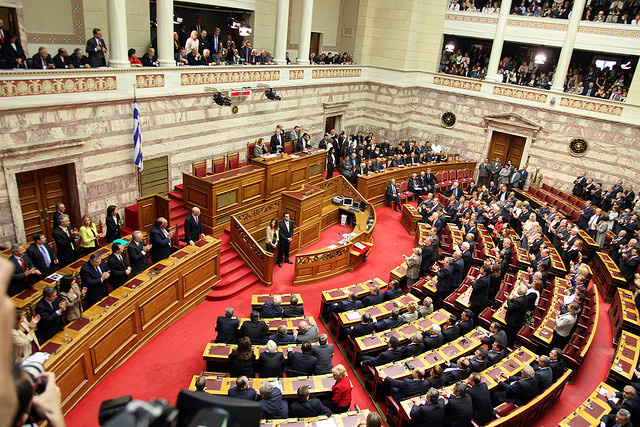Economy Watch: Greece Gets Temporary Deal, Investors Fret Over Italy
The Greek PM and his opposition leader have put together a "unity government" deal. The BLS saw anemic growth in employment nationwide. And the Monster Employment Index saw withering public employment as well.
November 7, 2011
By Dees Stribling, Contributing Editor
Greek Prime Minister George Papandreou and opposition leader Antonis Samaras have apparently cobbled together a deal for a “unity government” that might push forward the bailout of Greece by the more affluent euro-zone nations. Word is that Papandreou will soon not be the PM, but who will be hasn’t been clarified yet. Also unclear is how much austerity the opposition is willing to accept, should it become the government later, after elections that are going to be held before long, though no one’s quite sure when. As of Monday morning, a lot of things weren’t clear — as per usual with the Greek debt crisis.
So more volatility is entirely likely this week, and not just about Greece — whose economy, it should be remembered, is roughly the size of Maryland’s, with a GDP of $300 billion or so in 2010, according to the World Bank. Greece thus makes for mini-panics. A full-blown panic would be more fittingly associated with Italy, whose economy is roughly the size of California (just over $2 trillion in 2010, just a few hundred billion less than France and the United Kingdom).
Investor worries about Italy are already manifest. The yield on 10-year Italian debt upticked to 6.35 percent on Friday, a higher rate than even Spanish debt (another country with plenty of monetary woes), and the highest for Italy since it adopted the euro. Seven percent is considered, by some economists at least, the magic tipping point of doom for Italian debt. As recently as this summer, Italian debt was priced at less than 5 percent.
Government, Construction Jobs Drag Monthly Employment Numbers Down
Friday’s jobs report from the Bureau of Labor Statistics showed continued anemic growth in employment nationwide, with modest job creation in professional and businesses services, leisure and hospitality and health care, among other sectors. In October, private-sector employment increased by 104,000, but government jobs continued to evaporate.
Over the past 12 months, payroll employment has increased by an average of 125,000 per month, so October, with its net increase of 80,000 jobs, was below the recent average. Mainly because of variations in the number of discouraged workers — those who’ve given up on ever working again — the unemployment rate has fluctuated a little this year, but only within the range of 9 percent to 9.2 percent. As of October, the rate was 9 percent.
Construction employment declined by 20,000 in October, largely eating up an unexpected increase of 27,000 in September, though both month-over-month changes largely happened in nonresidential construction. Employment in both residential and nonresidential construction has shown little net change in 2011, according to the BLS.
Monster Index Also Says Public Employment Withering
The BLS is one thing, but what does the Monster Employment Index have to say about the U.S. jobs situation? “The index recorded positive momentum coming into the pre-holiday season,” Jesse Harriott, senior vice president and chief knowledge officer at Monster Worldwide, said in a statement on Friday. “Employers are proceeding with hiring as planned, indicated by solid seasonal demand for temporary workers in short-term positions within the retail and manufacturing sectors.”
In line with official employment tabulations, Monster also said that “public administration” (that is, government jobs) registered a steep annual decline in October, dropping about 30 percent year-over-year. That’s the lowest of the low-growth industries, according to Monster, well behind education, construction and real estate.
Wall Street stayed nervous on Friday, though perhaps not as much as earlier in the week. The Dow Jones Industrial Average lost 61.23 points, or 0.63 percent, while the S&P 500 was down 0.63 percent and the Nasdaq declined 0.44 percent.








You must be logged in to post a comment.